2010 Kawasaki Z1000 Review
Page 1 of 1
 2010 Kawasaki Z1000 Review
2010 Kawasaki Z1000 Review
Okay, we've now ridden the all-new Z1000,
and it brings to the sportbike table big grins, liter-class performance,
a wide range of capabilities and a wicked appearance, all at an MSRP
less than some 600cc sportbikes.
Now, the question yet to be answered is whether the American market
will continue its bone-headed aversion to any sportbike without a full
fairing. If they do, they will be missing out on one of the best
performance bargains available.
I once had a first-gen Z1000 as a long-term project bike, which gave
me plenty of time to learn its strong points and its deficiencies. Its
distinctive styling and hooligan demeanor gave it an enthralling
personality, but those positive attributes were countered by an
unbalanced suspension and a vibey motor. The old Z had its fans, but
there weren't enough of them. A 2007 revision calmed the annoying vibes
and had midrange-enhancing tricks to go along with its freshened
cosmetics, but continued slow sales caused it to be dropped from Kawi's
2009 lineup.
Improvements are so vast that comparisons to the previous iteration are
pointless. It's a well-engineered street-fighting machine that will be
difficult to humble by any of the illustrious naked sports bikes from
Europe.
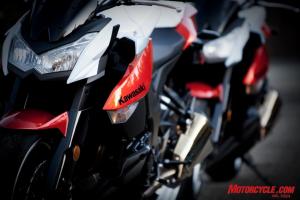 Kawasaki
Kawasaki
is giving the Z1000 another shot at the North American market, a bike
new from the ground up for 2010.
The new Zee begins with a completely new chassis and motor. Aluminum
now makes up the frame (and swingarm), lighter and stronger than the
previous steel frame. Rake and trail (24.5 degrees/4.05 inches) are
identical to the old bike, but it handles with poise the original could
only dream about.
Wheels spaced nearly an inch further apart add stability, yet a
weight reduction and improved mass centralization contributes to
exceptional agility for its displacement. With its smallish 4.0-gallon
tank full, it scales in 22 lbs lighter (481 lbs) than its 4.9-gallon
progenitor, for a net reduction of 16 lbs, 9 lbs of it solely from the
new alloy frame.
The Z-Thou's engine is a completely new inline-Four, sharing nothing
with the old Zee or the ZX-10R Now displacing 1043cc, the fuel-injected
mill gains 90cc and a secondary balancer from previous. The
stressed-member engine now mounts to the frame in four rather than three
mounting points, with a rubber mount above the transmission to reduce
the, er, transmission of vibration.
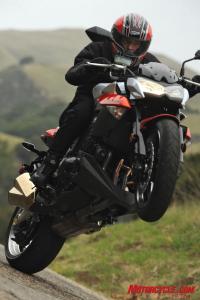 With an
With an
exhaust system hidden mostly from view, Duke thoughtfully gives us a
look.
A cold-air induction system is fed by intakes on each side of the
fuel tank and through the frame to a non-pressurized airbox. A tuned
“howl” is designed in by using a specifically shaped resonator chamber –
a strategically placed hole functions similar to blowing over a
bottle's mouth. Oval-shaped 38mm throttle bodies are fed by
differential-length intake snorkels to assist a torquey, broad powerband
Header pipes are linked with crossover tubes then into a large
chamber beneath the engine. As such, each controversially styled muffler
doesn't require as much volume, reducing weight by 1.5 lbs each. A
valve in the exhaust exists only in the right-side muffler (like the
2007-and-up versions).
Kawi says the engine spits out 138 crankshaft horsepower at 9600
revs, which will likely convert to nearly 125 ponies at the rear tire.
Torque is rated at a considerable 81.1 ft-lbs at 7800 rpm. After
wringing the Zee's neck (and later my rain gear) romping around the
soggy Cambria, California, I can say that not many people will be
wishing for more power.
Suspension is by Showa. The 41mm inverted fork now includes
compression-damping adjustability to the previous preload and rebound,
while the horizontally placed monoshock lacks only compression-damping
control. Rear preload, sadly, is by finicky locking rings rather than
the easy-to-tweak ramp-style collar.
More intricacies of the Z1000 can be seen in Pete's First Look
article seen here.
Japanese European Style
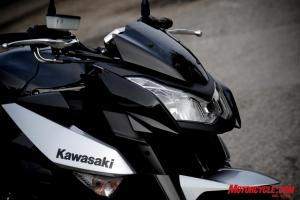 This is
This is
one of the most flattering views of the new Z1000, a complex mixture of
angles that maintains a sense of flow.
In Europe, the Zee is Zed, and it's been a hot seller on the
Continent. As such, the bike's new avant-garde styling is directed at a
Euro tastebud, as interpreted by a Japanese company. Trying to avoid
being called a “standard,” the Zed's appearance is Italian MV Agusta
Brutale blended with Japanese anime inspiration. It is an edgy,
future-forward design that has polarized pundits after seeing the first
pictures.
The Zee comes off more attractive in person, looking muscular and
distinctive. The central area of the bike is densely packaged, leaving
the blunt front end and tidy tailsection appearing relatively
diminutive. The black-anodized cast-aluminum frame spars wrap tightly
over the engine and narrow around the bike's waist for a slim fit for a
rider.
Although not fully faired, the Zee incorporates small side panels
that wrap around the radiator, plus an angular chin fairing that bleeds
into a black exhaust cover. Dual twin-exit mufflers continue the bike's
quad-exit theme seen on the Z1000's previous two generations. Its
cast-aluminum wheels receive machined edges on the rims and spoke ends
for a custom look that adds some bling.
Zee Ride
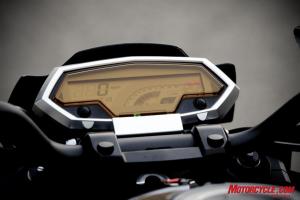 The
The
compact gauge cluster looks cool, but we're not keen on the small
bar-graph-style tachometer or the tinted cover.
Despite a bulky appearance, the Z proves to be quite slender between a
rider's knees, making for a straight shot at the ground for short legs
to feel secure despite the seat located 32.1 inches off the pavement,
and it broadens further rearward for better support. The upright riding
position feels just about perfect, with the solid-mount (previously
rubber-mounted) tubular handlebar neither too far forward nor too far
back. Tall riders might wish for a bit more space between the seat and
pegs for their legs, but a generous amount of fore/aft room on the seat
aids comfort for all.
Controls are easily accessed, and an adjustable front brake lever
fits every hand. The cable-actuated clutch requires a medium-effort pull
at the non-adjustable lever, and gear changes are kicked with minimal
effort. Images from the diamond-shaped mirrors aren't great for a naked
roadster, as forearms partially obstruct the unblurred view behind.
Kawi cleverly made the compact gauge package tiltable to three
positions, but instrumentation isn't the Z's strongest aspect. While the
LCD speedo is easy to read and a fuel gauge and clock are convenient,
the bar-graph tachometer display is too small to read at a glance, and
we're continually bemused why some manufacturers don't bother including a
gear-position indicator – the ECUs of all modern bikes know what gear
the transmission is in, so why can't its rider? We also think the yellow
tinted gauge face is a little goofy.
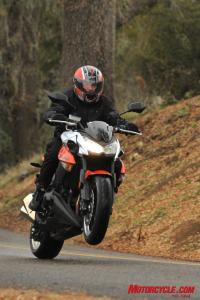 A
A
bodacious torque spread gives access to eye-watering acceleration
throughout the powerband.
However, instrument efficacy will be far from your mind once the big Z
is set into motion. Locomotive torque and a wide clutch engagement
bring you quickly up to whatever speed may be required. Cat-quick
steering response allows the streetfighter to carve traffic and canyons
with equal aplomb. I was surprised by how it was able to be maneuvered
fairly handily with only leg inputs, tossing it back and forth between
the knees without aid from the handlebar.
With an open road ahead of us, feeding in a handful of throttle
elicited even bigger grins. It pulls strongly from anywhere in the
seemingly lumpless powerband. Compared to the old Z, it has more power
from top to bottom. Acceleration in the lower gears is so intense that
the Z feels like it wants wants to headshake but doesn't. Hooligan types
will be happy to learn that wheelies in first gear are effortless, and
just slightly less so in second. Smooth throttle response assures a
rider gets exactly the power wanted, and a soft rev limiter cuts in
gently if you accidentally over-rev it past its 11K redline.
"It pulls strongly from anywhere in the
seemingly lumpless powerband."
The new Z's suspension proves to be compliant yet controlled, a huge
improvement from the unbalanced system of the original Z. Brakes weren't
tested much on our cold and wet day, but the radial-mount 4-piston
calipers and 300mm petal-shaped rotors promise good power. Initial bite
isn't intimidating, and feedback from the radial-pump master cylinder is
quite good. Dunlop D210 tires supplied reasonable grip in the
potentially treacherous condition we rode in.
Vestigial side panels offer a moderate amount of wind protection for
legs plus a location for the integrated front turn indicators, but a
rider's torso receives little deflection from the elements – this is a
naked bike, dummy. A taller flyscreen would be welcome on cold days or
long trips. Passengers will feel secure thanks to integrated grab
handles cleverly built into the die-cast aluminum subframe. The addition
of a counterbalancer drastically damps out the annoying vibrations of
the previous model.
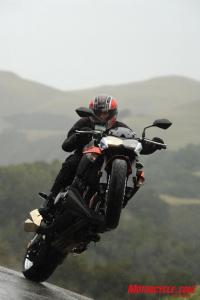 Even in
Even in
the rain, the thrilling new Z1000 satisfies.
We could whine about the Z1000's gauges or lack of rear
compression-damping adjustability, but those minor demerits add up to
nearly nothing when factoring in the dynamic experience of piloting the
fervid yet manageable Z1000. This truly is a sportbike that can
entertain a hardcore sport rider yet be a dextrous and multifaceted
motorcycle for real-world riding conditions.
In these days of rapidly escalating prices, sporting motorcycles
don't come much more value packed than the Z at its $10,499 MSRP. In
fact, the 2010 ZX-6R stickers at an identical price, which works out to
be $17.50 per cubic centimeter of engine displacement. The Z1000 costs
only about 10 bucks per cc!
"...Motorcycles don't come much more
value packed than the Z...The Z1000 costs only about 10 bucks per cc!"
We've been smitten by the Z in its previous nasty but flawed version,
and now it's gotten all of its wrinkles ironed out and wields an even
bigger punch. Now let's see if America is ready to throw down for one of
the most entertaining sportbikes for the street we know of, fairing or
not.
Related Reading
2010
Kawasaki Z1000 – First Ride
2010
Kawasaki Z1000 Unveiled
2010
Kawasaki Z1000 Euro Video Preview
2007
Kawasaki Z1000
2003
Naked 1000 Shootout
2010
Streetfighter Shootout: Kawasaki Z1000 vs. Triumph Speed Triple
and it brings to the sportbike table big grins, liter-class performance,
a wide range of capabilities and a wicked appearance, all at an MSRP
less than some 600cc sportbikes.
Now, the question yet to be answered is whether the American market
will continue its bone-headed aversion to any sportbike without a full
fairing. If they do, they will be missing out on one of the best
performance bargains available.
I once had a first-gen Z1000 as a long-term project bike, which gave
me plenty of time to learn its strong points and its deficiencies. Its
distinctive styling and hooligan demeanor gave it an enthralling
personality, but those positive attributes were countered by an
unbalanced suspension and a vibey motor. The old Z had its fans, but
there weren't enough of them. A 2007 revision calmed the annoying vibes
and had midrange-enhancing tricks to go along with its freshened
cosmetics, but continued slow sales caused it to be dropped from Kawi's
2009 lineup.
Improvements are so vast that comparisons to the previous iteration are
pointless. It's a well-engineered street-fighting machine that will be
difficult to humble by any of the illustrious naked sports bikes from
Europe.
 Kawasaki
Kawasaki is giving the Z1000 another shot at the North American market, a bike
new from the ground up for 2010.
The new Zee begins with a completely new chassis and motor. Aluminum
now makes up the frame (and swingarm), lighter and stronger than the
previous steel frame. Rake and trail (24.5 degrees/4.05 inches) are
identical to the old bike, but it handles with poise the original could
only dream about.
Wheels spaced nearly an inch further apart add stability, yet a
weight reduction and improved mass centralization contributes to
exceptional agility for its displacement. With its smallish 4.0-gallon
tank full, it scales in 22 lbs lighter (481 lbs) than its 4.9-gallon
progenitor, for a net reduction of 16 lbs, 9 lbs of it solely from the
new alloy frame.
The Z-Thou's engine is a completely new inline-Four, sharing nothing
with the old Zee or the ZX-10R Now displacing 1043cc, the fuel-injected
mill gains 90cc and a secondary balancer from previous. The
stressed-member engine now mounts to the frame in four rather than three
mounting points, with a rubber mount above the transmission to reduce
the, er, transmission of vibration.
 With an
With an exhaust system hidden mostly from view, Duke thoughtfully gives us a
look.
A cold-air induction system is fed by intakes on each side of the
fuel tank and through the frame to a non-pressurized airbox. A tuned
“howl” is designed in by using a specifically shaped resonator chamber –
a strategically placed hole functions similar to blowing over a
bottle's mouth. Oval-shaped 38mm throttle bodies are fed by
differential-length intake snorkels to assist a torquey, broad powerband
Header pipes are linked with crossover tubes then into a large
chamber beneath the engine. As such, each controversially styled muffler
doesn't require as much volume, reducing weight by 1.5 lbs each. A
valve in the exhaust exists only in the right-side muffler (like the
2007-and-up versions).
Kawi says the engine spits out 138 crankshaft horsepower at 9600
revs, which will likely convert to nearly 125 ponies at the rear tire.
Torque is rated at a considerable 81.1 ft-lbs at 7800 rpm. After
wringing the Zee's neck (and later my rain gear) romping around the
soggy Cambria, California, I can say that not many people will be
wishing for more power.
Suspension is by Showa. The 41mm inverted fork now includes
compression-damping adjustability to the previous preload and rebound,
while the horizontally placed monoshock lacks only compression-damping
control. Rear preload, sadly, is by finicky locking rings rather than
the easy-to-tweak ramp-style collar.
More intricacies of the Z1000 can be seen in Pete's First Look
article seen here.
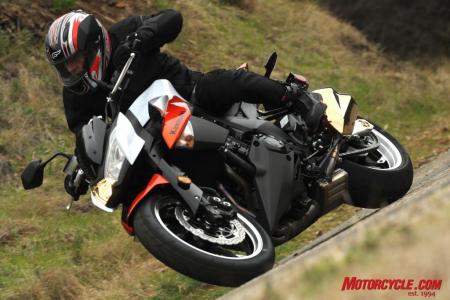 |
 This is
This is one of the most flattering views of the new Z1000, a complex mixture of
angles that maintains a sense of flow.
In Europe, the Zee is Zed, and it's been a hot seller on the
Continent. As such, the bike's new avant-garde styling is directed at a
Euro tastebud, as interpreted by a Japanese company. Trying to avoid
being called a “standard,” the Zed's appearance is Italian MV Agusta
Brutale blended with Japanese anime inspiration. It is an edgy,
future-forward design that has polarized pundits after seeing the first
pictures.
The Zee comes off more attractive in person, looking muscular and
distinctive. The central area of the bike is densely packaged, leaving
the blunt front end and tidy tailsection appearing relatively
diminutive. The black-anodized cast-aluminum frame spars wrap tightly
over the engine and narrow around the bike's waist for a slim fit for a
rider.
Although not fully faired, the Zee incorporates small side panels
that wrap around the radiator, plus an angular chin fairing that bleeds
into a black exhaust cover. Dual twin-exit mufflers continue the bike's
quad-exit theme seen on the Z1000's previous two generations. Its
cast-aluminum wheels receive machined edges on the rims and spoke ends
for a custom look that adds some bling.
| A Naked Sportbike: Will it sell in America this time around? |
| Albert Einstein's definition of insanity is doing the same thing over and over again and expecting different results. After two underwhelming attempts to peddle a streetfighter-style naked sportbike, one wonders if Kawasaki Motors Corp USA might be a little demented. They say the Z1000 is different this time around. “This really is one bike that a lot of people at Kawasaki are excited about,” commented Karl Edmondson, KMC's Product Manager. KMC had been frustrated by the sales performance of the previous Z1000s, especially since the bike was perennially near the top of the sales charts in Europe. Like other OEMs in America who had been burned by tepid response to naked sportbikes, Kawasaki had nearly given up hope on category, evidenced by the recently revised 2007 edition being dropped from the lineup in '09. <table align="center"> <tr> <td> 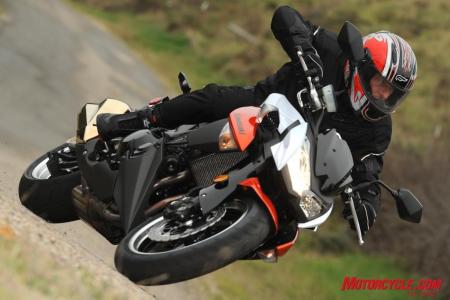 A new A new aluminum frame pares weight (9 lbs) and adds chassis stiffness – its torsional rigidity is said to be 30% greater. </td></tr></table> When word came from Japan that a new Z1000 was being prepared for a 2010 launch, KMC yawned – thanks but no thanks. However, that was before Edmondson and his boss rode the pre-production development Z1000 at Kawi's racetrack in Japan. They enjoyed the Z more than they ever thought possible, causing KMC to make an abrupt about-face and deciding to give the much improved Z another chance at the North American market. KMC knows it has a potential hit on its hands if American sport riders can get over their irrational fear that a sportbike without a fairing can't really be a sportbike. They – like the staff at Motorcycle.com – believe in the versatility and reasonable comfort offered by a naked roadster like the Z. 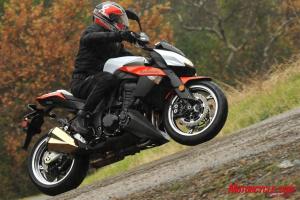 A sporty A sporty but neutral riding position gives this sportbike some real-world usability. In 2002, Kawasaki announced a tighter focus on racetrack abilities for its sportbikes. But the ultra-sporting ZXs aren't optimum for sportbike riders who don't ride on the track. It's a simple fact that a racebike will be compromised in terms of its street performance, but race-replica 600cc sportbikes nevertheless make up about 50% of the American sportbike market. Kawi notes that sport riders want the best of everything and that the common perception is one needs to buy a premium sportbike to get “the best.” The Z1000 intends to obliterate that perception. “I was one of those who wasn't really a fan of the old bike,” Edmondson admitted, “but nothing on this bike is carried over from the old bike. “Now, for a lot of people at KMC, this is their favorite bike.” “It's not your father's Z1000,” added Jeff Herzog, Senior Media Relations Coordinator for KMC. “It's a Versys on steroids.” |
 The
The compact gauge cluster looks cool, but we're not keen on the small
bar-graph-style tachometer or the tinted cover.
Despite a bulky appearance, the Z proves to be quite slender between a
rider's knees, making for a straight shot at the ground for short legs
to feel secure despite the seat located 32.1 inches off the pavement,
and it broadens further rearward for better support. The upright riding
position feels just about perfect, with the solid-mount (previously
rubber-mounted) tubular handlebar neither too far forward nor too far
back. Tall riders might wish for a bit more space between the seat and
pegs for their legs, but a generous amount of fore/aft room on the seat
aids comfort for all.
Controls are easily accessed, and an adjustable front brake lever
fits every hand. The cable-actuated clutch requires a medium-effort pull
at the non-adjustable lever, and gear changes are kicked with minimal
effort. Images from the diamond-shaped mirrors aren't great for a naked
roadster, as forearms partially obstruct the unblurred view behind.
Kawi cleverly made the compact gauge package tiltable to three
positions, but instrumentation isn't the Z's strongest aspect. While the
LCD speedo is easy to read and a fuel gauge and clock are convenient,
the bar-graph tachometer display is too small to read at a glance, and
we're continually bemused why some manufacturers don't bother including a
gear-position indicator – the ECUs of all modern bikes know what gear
the transmission is in, so why can't its rider? We also think the yellow
tinted gauge face is a little goofy.
 A
A bodacious torque spread gives access to eye-watering acceleration
throughout the powerband.
However, instrument efficacy will be far from your mind once the big Z
is set into motion. Locomotive torque and a wide clutch engagement
bring you quickly up to whatever speed may be required. Cat-quick
steering response allows the streetfighter to carve traffic and canyons
with equal aplomb. I was surprised by how it was able to be maneuvered
fairly handily with only leg inputs, tossing it back and forth between
the knees without aid from the handlebar.
With an open road ahead of us, feeding in a handful of throttle
elicited even bigger grins. It pulls strongly from anywhere in the
seemingly lumpless powerband. Compared to the old Z, it has more power
from top to bottom. Acceleration in the lower gears is so intense that
the Z feels like it wants wants to headshake but doesn't. Hooligan types
will be happy to learn that wheelies in first gear are effortless, and
just slightly less so in second. Smooth throttle response assures a
rider gets exactly the power wanted, and a soft rev limiter cuts in
gently if you accidentally over-rev it past its 11K redline.
"It pulls strongly from anywhere in the
seemingly lumpless powerband."
The new Z's suspension proves to be compliant yet controlled, a huge
improvement from the unbalanced system of the original Z. Brakes weren't
tested much on our cold and wet day, but the radial-mount 4-piston
calipers and 300mm petal-shaped rotors promise good power. Initial bite
isn't intimidating, and feedback from the radial-pump master cylinder is
quite good. Dunlop D210 tires supplied reasonable grip in the
potentially treacherous condition we rode in.
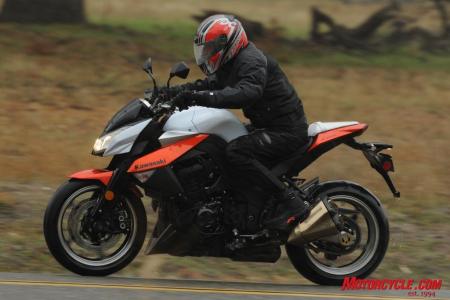 Plenty of Plenty of seat room allows a rider to scoot back into a crouched riding position better able to cope at higher speeds. |
legs plus a location for the integrated front turn indicators, but a
rider's torso receives little deflection from the elements – this is a
naked bike, dummy. A taller flyscreen would be welcome on cold days or
long trips. Passengers will feel secure thanks to integrated grab
handles cleverly built into the die-cast aluminum subframe. The addition
of a counterbalancer drastically damps out the annoying vibrations of
the previous model.
 Even in
Even in the rain, the thrilling new Z1000 satisfies.
We could whine about the Z1000's gauges or lack of rear
compression-damping adjustability, but those minor demerits add up to
nearly nothing when factoring in the dynamic experience of piloting the
fervid yet manageable Z1000. This truly is a sportbike that can
entertain a hardcore sport rider yet be a dextrous and multifaceted
motorcycle for real-world riding conditions.
In these days of rapidly escalating prices, sporting motorcycles
don't come much more value packed than the Z at its $10,499 MSRP. In
fact, the 2010 ZX-6R stickers at an identical price, which works out to
be $17.50 per cubic centimeter of engine displacement. The Z1000 costs
only about 10 bucks per cc!
"...Motorcycles don't come much more
value packed than the Z...The Z1000 costs only about 10 bucks per cc!"
We've been smitten by the Z in its previous nasty but flawed version,
and now it's gotten all of its wrinkles ironed out and wields an even
bigger punch. Now let's see if America is ready to throw down for one of
the most entertaining sportbikes for the street we know of, fairing or
not.
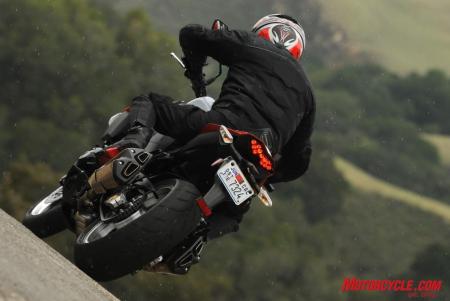 |
2010
Kawasaki Z1000 – First Ride
2010
Kawasaki Z1000 Unveiled
2010
Kawasaki Z1000 Euro Video Preview
2007
Kawasaki Z1000
2003
Naked 1000 Shootout
2010
Streetfighter Shootout: Kawasaki Z1000 vs. Triumph Speed Triple
ganahsokmo- Join date : 16/01/2010
Age : 43
 Similar topics
Similar topics» 2010 Kawasaki Z1000 recall
» 2010 Kawasaki ZX-10R Review
» 2010 Kawasaki Versys Review
» 2010 Kawasaki Concours 14 Review
» 2010 Kawasaki KLX110 & KLX110L Review
» 2010 Kawasaki ZX-10R Review
» 2010 Kawasaki Versys Review
» 2010 Kawasaki Concours 14 Review
» 2010 Kawasaki KLX110 & KLX110L Review
Page 1 of 1
Permissions in this forum:
You cannot reply to topics in this forum

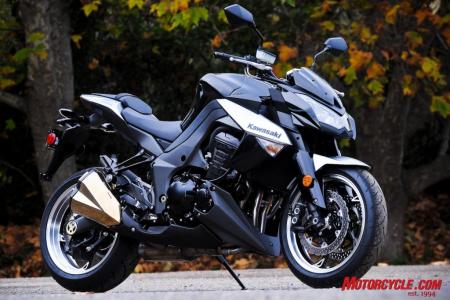 The 2010
The 2010 
